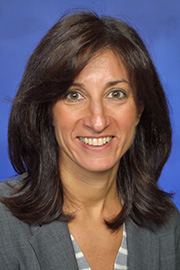
Nancy Kline, PhD, OTR, BCG
Assistant Professor, Part Time
Occupational Therapy
Dr. Nancy Finkelstein Kline is an Assistant Professor in the Occupational Therapy Program at SUNY Downstate Medical Center with over 40 years of clinical experience in acute care, rehabilitation, and home care for individuals with acquired brain injuries and neurological disorders.She earned her BS in Occupational Therapy from Boston University, an MA from Washington University in St. Louis, and a PhD focused on brain injury from New York University.
Dr. Kline’s research centers on supporting meaningful living for older adults with neurological conditions. She is Co-Director of the HRSA BRIDGE grant, promoting interprofessional training to improve care for older adults in underserved communities.
She teaches courses in Cognition and Perception, Neurologic Rehabilitation, and a seminar in Human Neuroanatomy for occupational therapy students. She also teaches neurology in Medical Sciences and contributes to the Geriatrics & Palliative curriculum for medical students.
Dr. Kline is on the Editorial Review Board for Disability and Rehabilitation and serves on AOTA’s Standard Setting Committee for the Gerontology Board Certification.
She holds AOTA Board Certification in Gerontology (2018–2027) and is certified in LSVT BIG, a treatment for Parkinson’s disease, through 2028.
Education
- PhD in Occupational Therapy, New York University, 1997
- Master of Arts in Education, Washington University, 1985
- Bachelor of Science in Occupational Therapy, Boston University, 1981
Advanced trainings or credentials
- NDT 1984
- LSVT BIG Certification 2015, 2017
- Board Certification in Geriatrics by the American Occupational Therapy Association
- Kline, N. (2014) Asher's Occupational Therapy Assessment Tools: an annotated index: cognitive assessments. 4th edition. Edited by Ina Elfant Asher. AOTA Press.
- Gillen, G., Scaffa, M., Cohn, E. (2013) Willard and Spackman's Occupational Therapy 12th ed. Edited cognitive chapter and on review board.
- Kline, N. (2007) Assessment Tools: an annotated index: cognitive assessments. 3rd edition. Edited by Ina Elfant Asher. AOTA Press.
- Kaplan, MK, Kline, N, & Sabari, J. (2006). The Importance of NDT in Analyzing Posture and Movement
- Finkelstein Kline, N. (2000). Validity of the modified dynamic visual processing assessment, 9 (4) E69-E88 Israel Journal of Occupational Therapy Research.
Dr. Kline's research focuses on the role of visual perception and cognition in everyday life and during functional mobility.